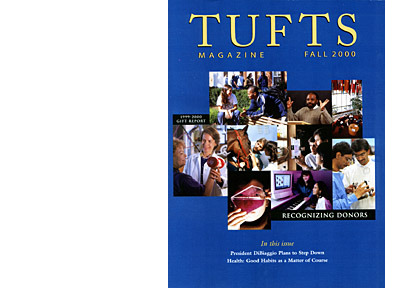| |

About this Issue
What's in a Name
In some ways, this first issue of Tufts Magazine is
not a new publication. Granted, it weighs a few ounces more than
Tuftonia. Its heft reflects the decision to include, for the first
time, an extensive recognition of donors. You'll be seeing much
more of the traditional fare of news and features in future issues.
On the occasion of a name change, we find that little
has really changed beyond the masthead. Tufts Magazine will continue
to be a home for the voices of Tufts many graduates. Indeed, it
is these voices that most often have given the magazine its distinctive
flavor.
Consider the February 1930 Tufts College Alumni Bulletin,
where we find John Libby, secretary of the Maine Tufts Club, giving
the upshot of an annual meeting in Portland. The distinguished speaker,
Professor 'Pop' Houston, was late. "Upon his arrival, the roast
chicken began to disappear," writes Libby. "Then the temporary
secretary took charge of the meeting, and realizing the helplessness
of the gathering to stop him, proceeded to voice some characteristic
views. Finally he ran out of gas and gave Prof. Houston a chance
to open his bag of news from the Hill."
Meanwhile, over in Pittsburgh, Tufts graduates faced
the new year with confidence. "Our campaign to have the brothers
and sisters pay their dues has been remarkably successful, with
eleven out of thirty-five paying their fifty cents within two months
of when they were first asked," signed, "Yours in the
bonds, William Maulsby, Sec."
In the early 1940s, alumni were hardly stifled by
the diminished size of the Bulletin (a mere three by four inches,
in observance of the war effort). The editor was up to the challenge.
Notable deeds of graduates were collected under the department "The
Little Beggar," the sobriquet of a Scottie poised for a biscuit
of news.
Writes the editor: "Under the whiplash of Marjorie
Gott, J40, the Wee Scottie performs in the interests of Alumni."
It is the sincere sentiment of Miss Gott that class notes "should
be both the pride of alumni, and presented in a delectable manner
by themselves, about themselves, for themselves. Classmates ought
to have the truth, the whole truth, etc.- varnished or unvarnished,
rubbed down with the pumice of circumstance and polished with the
writer's wit. In this way will these pages become of such interest
as to entice the reader beyond the limits of his own class and time-Millennium!"
Subsequent Tufts alumni magazines--Tufts Topics, the
Tufts Alumni Review, The Criterion and Tuftonia--carried on this
enthusiasm through decades marked by enormous changes. Today, Tufts
Magazine has its own set of challenges. It is now sent to more than
70,000 graduates. And judging from the unbroken stream of class
notes and club reports, we are more than prepared for the "Millennium"
that Miss Gott so earnestly envisioned.
The publication does, however, prompt us to take
a closer look at how we, as editors, do our job. In our stories,
we must anticipate an array of readers' needs, exemplify the excellence
and vitality of the university, stimulate thought, provoke discussion
and inspire action. In short, we must renew a focus on better ways
to communicate. We look foward to sharing these with you here on
the pages of the new, and not-so-new, Tufts Magazine.
Laura Ferguson
Editor-in-Chief
top
|





